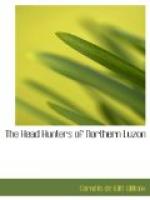“Finally, it should be clearly borne in mind that the Filipinos have been given an excellent opportunity to demonstrate practically their interest in the non-Christians, and their ability wisely to direct the affairs of primitive peoples. While the inhabitants of the Mountain Province, Nueva Vizcaya, Agusan, and the Moro Province are not now subject to control by them, and the inhabitants of Mindoro and Palawan are subject to their control only through the Philippine Legislature, there are non-Christian inhabitants in the provinces of Cagayan, Isabela [and eighteen others].
“At the outset, these governors and provincial boards [i.e., of the provinces just mentioned] exercised over their non-Christian constitutents precisely the same control they had over Filipinos. To the best of my knowledge and belief, not one single important measure looking to the betterment of the condition of these non-Christian inhabitants was ever inaugurated by a Filipino during this period. Indeed, the fact that no expense would be voluntarily incurred for them became so evident as to render necessary the passage, on December 16, 1905, of an act setting aside a portion of the public revenues for the exclusive benefit of the non-Christians.
“After Apayao was established as a sub-province of Cagayan and the duty of providing funds for the maintenance of its government was explicitly imposed upon the provincial board of that province, the governor stated to me that, in his opinion, it would be useless to make the necessary expenditure, and that, in his opinion, it would be better to kill all the savages in Apayao! As they number some 52,000, this method of settling their affairs would have been open to practical difficulties, apart from any humanitarian consideration!”
“Contrast with this record of inaction and lack of interest the record of the special Government provinces [49] and the Moro Province, where dwell really formidable tribes, which have until recently engaged in piracy, head-hunting, and murder. Here very extensive lines of communication have been opened up by the building of roads and trails and the clearing of rivers. A good state of public order has been established. Head-hunting, slavery, and piracy are now very rare. The liquor traffic has been almost completely suppressed. Life and property have been rendered comparatively safe, and in much of the territory entirely so. In many instances, the wild men are being successfully used to police their own country. Agriculture is being developed. Unspeakably filthy towns have been made clean and sanitary. The people are learning to abandon human sacrifices and animal sacrifices and to come to the doctor when injured or ill. Numerous schools have been established and are in successful operation. The old sharply drawn tribal lines are disappearing. Bontoc Igorots, Ifugaos, and Kalingas now visit each other’s territory. At the same time that all of this has been accomplished, the good-will of the people themselves has been secured. They are outspoken in their appreciation of what has been done for them and in their expression of the wish that American rule should continue. They would be horror-stricken at the thought of being turned over to Filipino control,” [50]




